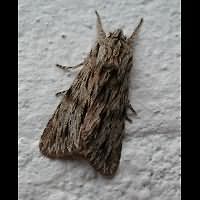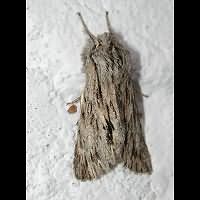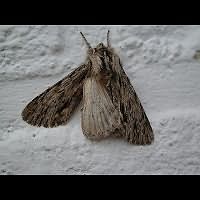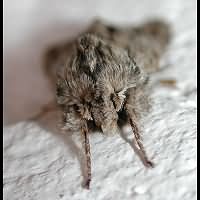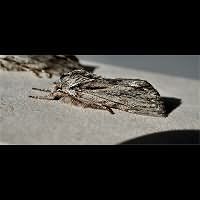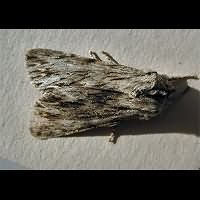The Sprawler Asteroscopus sphinx
The Sprawler is a rather dull Noctuid. The combination of the following characteristics make it an unmistakable species, though: the thorax is very hairy, the wings have a pattern of long streaks and the animal flies very late in the year in October and part of November mainly. It seemingly doesn't care about bad weather. That's mainly because the adult moths don't eat. There are only slight variations in markings, but the ground colour may be lighter or darker in individuals. Males have feathered antennae, females have threadlike antennae. Wingspan: 39 to 48 mm.
The eggs are deposited in autumn in crevices in tree barks. They hatch in May. The small caterpillars are true cannibals. Usually not very many survive the first few weeks. By the end of June they move to the ground. Here they dig a deep hole, in which pupation takes place. The adult moth may be an unobtrusive one, the caterpillar is not. It has a thick yellow line running over the spiracula. Below this line, the animal is dark green, above the line whitish green. On the back are a few whitish dorsal lines. The 11th segment has a clear hump. The last segments run down almost vertically. The caterpillar assumes a curious pose, especially when it feels threatened: the first part of the body is curled backwards. That's why it is called the Sprawler in English and sphinx scientifically. Taking into consideration the wingspan, the caterpillar of the Sprawler is big, for it may reach a length of some 43 to 48 mm.
The Sprawler is on the wing in October mainly. Is active during low temperatues and rain. It is easily attracted to light and can be found next day on fences or walls, sometimes in great numbers. When resting like this they can be photographed easily, for they have no tendency to fly away. A common species in woodlands in the south of England and Wales. A local species northwards and in Ireland. Not found in Scotland. Common in most parts of the continent, but not in Northern Europe.
In many books and on the web the former scientific name of Brachionycha sphinx is still used frequently.
The Sprawler is a rather dull Noctuid. The combination of the following characteristics make it an unmistakable species, though: the thorax is very hairy, the wings have a pattern of long streaks and the animal flies very late in the year in October and part of November mainly. It seemingly doesn't care about bad weather. That's mainly because the adult moths don't eat. There are only slight variations in markings, but the ground colour may be lighter or darker in individuals. Males have feathered antennae, females have threadlike antennae. Wingspan: 39 to 48 mm.
The eggs are deposited in autumn in crevices in tree barks. They hatch in May. The small caterpillars are true cannibals. Usually not very many survive the first few weeks. By the end of June they move to the ground. Here they dig a deep hole, in which pupation takes place. The adult moth may be an unobtrusive one, the caterpillar is not. It has a thick yellow line running over the spiracula. Below this line, the animal is dark green, above the line whitish green. On the back are a few whitish dorsal lines. The 11th segment has a clear hump. The last segments run down almost vertically. The caterpillar assumes a curious pose, especially when it feels threatened: the first part of the body is curled backwards. That's why it is called the Sprawler in English and sphinx scientifically. Taking into consideration the wingspan, the caterpillar of the Sprawler is big, for it may reach a length of some 43 to 48 mm.
The Sprawler is on the wing in October mainly. Is active during low temperatues and rain. It is easily attracted to light and can be found next day on fences or walls, sometimes in great numbers. When resting like this they can be photographed easily, for they have no tendency to fly away. A common species in woodlands in the south of England and Wales. A local species northwards and in Ireland. Not found in Scotland. Common in most parts of the continent, but not in Northern Europe.
In many books and on the web the former scientific name of Brachionycha sphinx is still used frequently.

